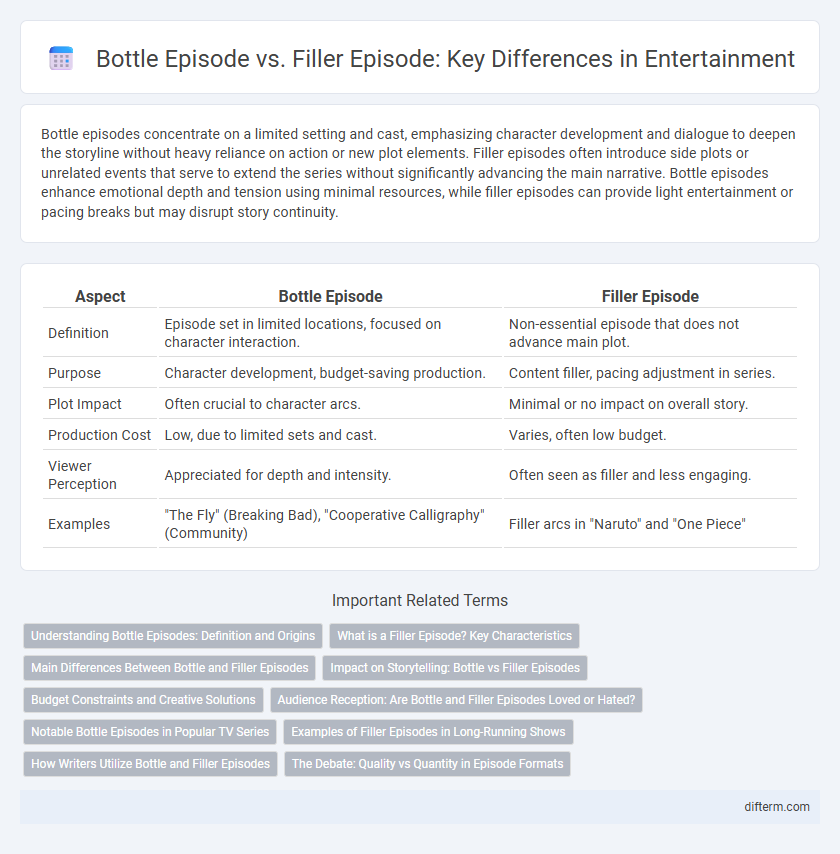Bottle episodes concentrate on a limited setting and cast, emphasizing character development and dialogue to deepen the storyline without heavy reliance on action or new plot elements. Filler episodes often introduce side plots or unrelated events that serve to extend the series without significantly advancing the main narrative. Bottle episodes enhance emotional depth and tension using minimal resources, while filler episodes can provide light entertainment or pacing breaks but may disrupt story continuity.
Table of Comparison
| Aspect | Bottle Episode | Filler Episode |
|---|---|---|
| Definition | Episode set in limited locations, focused on character interaction. | Non-essential episode that does not advance main plot. |
| Purpose | Character development, budget-saving production. | Content filler, pacing adjustment in series. |
| Plot Impact | Often crucial to character arcs. | Minimal or no impact on overall story. |
| Production Cost | Low, due to limited sets and cast. | Varies, often low budget. |
| Viewer Perception | Appreciated for depth and intensity. | Often seen as filler and less engaging. |
| Examples | "The Fly" (Breaking Bad), "Cooperative Calligraphy" (Community) | Filler arcs in "Naruto" and "One Piece" |
Understanding Bottle Episodes: Definition and Origins
Bottle episodes are television episodes produced with limited sets and characters to reduce production costs, often focusing on character development and dialogue-driven storytelling. Originating in the 1960s, the term "bottle episode" derives from the idea of containing the narrative within a confined "bottle" or single location. These episodes contrast with filler episodes, which typically advance the plot less significantly and often serve as temporal narrative padding.
What is a Filler Episode? Key Characteristics
A filler episode in entertainment is designed to maintain continuity without advancing the main plot, often featuring side stories or character development unrelated to the core narrative. Key characteristics include minimal impact on overall storyline progression, standalone plotlines that can be skipped without losing essential information, and an emphasis on humor, world-building, or character interaction. These episodes serve as pacing tools, allowing production time or giving audiences a break from intense story arcs.
Main Differences Between Bottle and Filler Episodes
Bottle episodes primarily take place in a single location to minimize production costs and focus on character development, whereas filler episodes usually advance the plot without significant character growth and often feature diverse settings. Bottle episodes emphasize dialogue and internal conflict, allowing deeper exploration of relationships, while filler episodes serve to maintain viewer engagement during slower narrative periods. The main difference lies in their purpose: bottle episodes enhance storytelling through constrained environments, and filler episodes maintain pacing without critical story advancement.
Impact on Storytelling: Bottle vs Filler Episodes
Bottle episodes concentrate on a confined setting and limited characters, intensifying character dynamics and dialogue, which enhances emotional depth and plot development efficiently. Filler episodes often introduce side plots or isolated events that may slow main story progression, providing world-building or character background but risking viewer disengagement. The impact on storytelling hinges on bottle episodes fostering narrative cohesion and thematic focus, while filler episodes can dilute pacing but support longer series arcs.
Budget Constraints and Creative Solutions
Bottle episodes often arise from tight budget constraints, utilizing limited sets and focusing on character-driven dialogue to reduce production costs. Filler episodes, while sometimes less costly than major plot episodes, typically serve to extend storylines or provide background without necessarily employing significant budget-saving techniques. Creative solutions in bottle episodes encourage innovative storytelling through confined spaces, whereas filler episodes prioritize narrative padding over cost efficiency.
Audience Reception: Are Bottle and Filler Episodes Loved or Hated?
Bottle episodes, known for their limited sets and intense character focus, often garner praise for deepening storytelling and showcasing strong performances, appealing to devoted viewers seeking emotional depth. In contrast, filler episodes typically receive criticism for disrupting plot momentum and offering little character development, leading to frustration among audiences eager for meaningful progression. While bottle episodes can elevate a series' quality and viewer engagement, filler episodes risk diminishing interest and perceived value of the narrative.
Notable Bottle Episodes in Popular TV Series
Bottle episodes save production costs by confining the narrative to a limited setting while intensifying character development and dialogue. Notable bottle episodes include "The One Where No One's Ready" from Friends, showcasing a chaotic apartment stuck in real-time, and "Fly" from Breaking Bad, where Walter White and Jesse Pinkman grapple with tension in a single lab room. These episodes often become fan favorites for their creative storytelling and sharp focus on character dynamics within constrained environments.
Examples of Filler Episodes in Long-Running Shows
Filler episodes in long-running shows like "Naruto" often include standalone stories that do not advance the main plot, such as the "Land of Tea Escort Mission," which provides character development but lacks impact on the overall narrative. In "The Simpsons," episodes like "Treehouse of Horror" are considered filler as they deviate from the show's continuity with non-canonical, Halloween-themed stories. While filler episodes may sometimes feel less essential, they offer opportunities for humor, character exploration, and creative storytelling within popular series.
How Writers Utilize Bottle and Filler Episodes
Writers utilize bottle episodes by confining the story to a single location and limited cast to intensify character development and dialogue, often reducing production costs while highlighting emotional depth. In contrast, filler episodes serve as narrative pauses that expand the storyline with side plots or lighter content, maintaining audience engagement without advancing the main plot significantly. Both episode types strategically balance pacing and budget constraints while enriching the overall story arc and character dynamics.
The Debate: Quality vs Quantity in Episode Formats
Bottle episodes concentrate on limited settings and cast to maximize narrative depth and character development, enhancing quality through focused storytelling. Filler episodes often serve to meet production demands, sometimes sacrificing plot progression and viewer engagement for quantity. The debate between these formats centers on whether audiences prefer tightly crafted, meaningful content or a greater number of episodes that maintain series continuity.
Bottle episode vs filler episode Infographic

 difterm.com
difterm.com